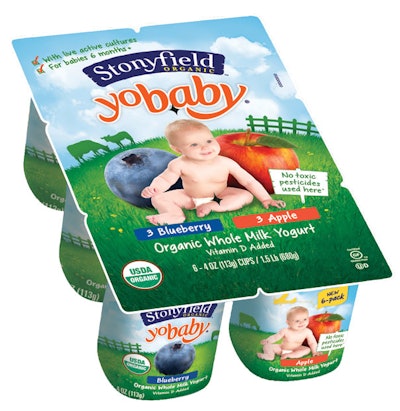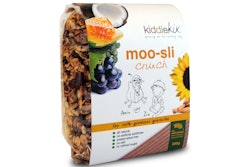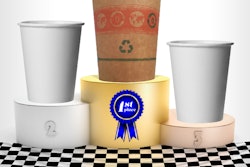We’ve seen some pretty notable and innovative biobased applications in packaging lately. Last year, Nofima released a new bioplastic that was made of shrimp shells, using the chitin to produce a degradable material. And this year, Coke made international news when it announced its biobased bottle, made with 30% renewable content. Many other biobased packaging formats are in stores now, and sometimes consumers are none the wiser.
The key distinguishing difference between biopolymers and the conventional polymers we’re all familiar with is that biopolymers are sourced not from petroleum but rather from biological sources. In other words, things that grow.
European Bioplastics e.V., a Europe-based association representing the European bioplastics industry, includes member companies like NatureWorks, DuPont, Corbion, Braskem, Novamont, BASF, Innovia, Meredian, to name a few. These companies are heavily involved in the bioplastics industry and are actively producing and/or supplying the industry with bioplastics.
European Bioplastics’ deputy managing director Kristy-Barbara Lange says that there are numerous benefits to using bioplastics in packaging, including increased resource efficiency because the resources relied upon are renewable. She also notes that there are several certifications, such as ISCC Plus, to ensure that resources are grown sustainably. Lower carbon footprint is another benefit; sometimes even carbon neutrality is possible. Sometimes end-of-life options are highly desireable, compostability for food packaging being one example. Optimized technical properties such as controlled permeability or specific aroma barriers are other benefits that can be gained.
Production and converting
When a converter starts thinking about running any new material, of course alterations may be necessary. And the consensus is that bioplastics and biopolymers are largely very similar to their conventional counterpart in terms of needing to adjust slightly when converting a new material. Dr. Isao Noda, Chief Science Officer at bioplastics producer MHG, puts it this way.
“Some changes to the converting process are necessary, such as process temperature, range, etc. But some of today’s bioplastics are getting so close to the conventional petroleum-based plastics as to be essentially a drop-in substitute for some key applications.”
In agreement is Steve Davies, Director of Corporate Communications and Public Affairs at NatureWorks, a maker of plant-based biopolymer PLA (polylactic acid). “Every polymer is different in terms of converting. Polypropylene, PET, Polystrene—each is handled differently. A biopolymer such as PET would be processed indistinguishably from fossil-based PET. NatureWorks’ Ingeo product is most similar to PET in terms of how it processes in converting equipment. One of the reasons that it takes time for any new-to-market material to become widely used is that the converters have a learning curve, and machinery manufacturers have to provide the right technology to handle and convert it. This ramp up adds cost and time for adoption,” says Davies.
Lange echoes Davies’ opinion on the converting of biobased materials. “Parameters of existing machines are adapted slightly,” she says, “but most bioplastics can be processed on the same machines as conventional plastics. For example, biobased polyethylene is not different in its properties from conventional PE—except for a lower carbon footprint.”
Real world applications
NatureWorks’ product materials are called Ingeo. Davies says, “These biopolymers are designed to span packaging uses that range from flexible films, to food serviceware, to thermoformed and form/fill/seal packaging. Yogurt containers and other cups used for take-and-go snacks are an excellent application for Ingeo. The performance and the cost structure are competitive with polystyrene in FFS packaging.”
Foam trays that are typically used for refrigerated meats, cheeses, poultry, pork, and other similar items are also suitable applications for Ingeo trays. “The reason is that Ingeo foam trays are compostable in areas where a composting infrastructure has been set up. Seattle is one of the places where Ingeo foam is the go-to material for these trays and takeout containers,” Davies explains.
The NatureWorks’ packaging films have breathability characteristics ideal for keeping fresh produce fresh. Ingeo film is also used in the candy industry due to its low carbon footprint credentials. Ingeo’s stiffness also makes a nice clamshell package, requiring less material per package than conventional PET.
According to Davies, Ingeo biopolymer is made by converting plant starches into a polymer through a high tech, patented fermentation process. He says this biopolymer has three important competitive advantages, the first of which is its ability to provide unique performance attributes on some applications. Two examples:
• In form/fill/seal packaging, Ingeo properties allow lightweighting of the package, while still offering better protection of the contents. The value for the customer is source reduction, as less material is used.
• Ingeo foam deli and meat trays that are contaminated with food waste can be composted and thus divert organic food waste from landfills in areas where there is a composting infrastructure.
The second advantage that comes with Ingeo, says Davies, is that it offers price stability over the long run compared to volatile pricing of anything based on fossil resources. And third, says Davies, Ingeo is based on renewable abundant resources that give it superior environmental credentials such as less energy to manufacture and fewer greenhouse gases emitted during manufacture. It also means that Ingeo will be increasingly sought after as ever decreasing fossil carbon resources are used for more durable products than packaging. All three are important to consumer brand companies looking for economic, social, and environmental sustainability, concludes Davies.
Cost savings
Are there cost savings when using this type of material option vs. a “synthetic” polymer? Depending upon the type of use, there definitely can be. Davies points to form/fill/seal yogurt cups as an example. These are primarily made with polystyrene, a material that some brands may want to move away from since some studies have linked styrene to cancer. Ingeo biopolymer offers better price stability than polystyrene and also brings these advantages:
• the opportunity to down gauge to thinner packaging and use less material,
• manufacturing energy savings through lower temperature forming,
• better lid adhesion,
• less breakage/cracking,
• improved protection during shipping.
Noda sees a very clear cost savings, especially if one considers that at end of life most plastic articles saddle us with the cost of disposal. Noda also points out that the production of bioplastics is getting more cost competitive.
Lange also sees cost benefits that come with bioplastics, especially if package producers and their customers leverage barrier properties that deliver extended shelf life. She also believes that as manufacturing continues to scale up, the pricing on bioplastics will grow more favorable.
Still there are hurdles that bioplastics will have to overcome. Especially tricky is the whole business of life cycle analysis. Not only is there no level playing field across the globe, LCA is always an act of interpretation at some level.
Also, notes Lange, there’s a messaging issue. If wrong information continues to be disseminated—such as claims that bio-based plastics are automatically biodegradable, or that bioplastics are a license to litter since they’ll decompose anyway—the growth of biopolymers in packaging could be hindered.
International interest in biopolymer packaging
While Europe has been earlier than most regions to embrace biobased packaging on a sizeable scale, it seems that biobased packaging options now have an international reach. European Bioplastics’ Lange has seen this firsthand. “Europe is the frontrunner with regard to R&D and is a very interesting market. Converting is also well represented. Production, however, is developing faster in other regions—mainly Asia, but also in North America and South America.” She thinks a missing piece of the biobased packaging puzzle is a legislative framework that guarantees security for investments and also establishes a level playing field amongst the bio-industries.
Noda sees the U.S. as a strong contender in biobased materials production: “Europe started earlier, but the U.S. is catching up rapidly, especially with the emerging availability of high-quality and cost-competitive bioplastics.”
For Davies, Europe’s strict legislation and cost of oil are the main reasons for a strong presence in the bioplastics industry. “This means the European industry is often quicker to adopt more environmentally friendly and energy efficient manufacturing practices. This helps to drive market interest in biobased materials. All that said, it’s not that the U.S. is waiting to catch up with Europe, and in terms of commercial investment, the U.S. and parts of Asia are moving much more quickly. NatureWorks is one of the leading biopolymer companies in the world and it is based in the U.S., not Europe. A large portion of our sales is in North America and Asia, and Asian countries such as Thailand and Malaysia are moving much more aggressively than Europe to court further investment in biobased materials,” says Davies.
“Bioplastics production capacities grow 20% to 100% per year—right now they are about 1% of all the annually produced plastic,” says Lange. Packaging, she adds, is the leading market segment: about 40% of bioplastics produced are made into packaging solutions.
Noda has an optimistic outlook for biobased packaging options. “We anticipate a rapid shift in the packaging industry to bioplastics, once there are enough materials with decent physical properties at a competitive price and we have a robust supply chain in place.”
Stay tuned where biopolymers in packaging are concerned—or risk getting left behind.
‘Very, very Clicquot’
With this year’s introduction of a package called Naturally Clicquot 2, world famous champagne producer Veuve Clicquot has moved onto biopolymer package 2.0. The French firm’s first effort, dubbed Naturally Clicquot, came out in 2014. Both versions are injection molded of PaperFoam, a starch-based material developed by a Dutch firm that also goes by the name PaperFoam. Not only is the material made from a renewable resource and compatible with the recycled paper stream, it has been validated by Belgium’s AIB-Vincotte International to be 100% compostable at home or in an industrial facility.
The raw materials in the slurry used to make both the top and the bottom of this two-part package are identified by PaperFoam as industrial starch (typically from potatoes), “natural fibers,” water, and “premix.” Production is a high-precision process done in custom-made aluminum tools on PaperFoam injection molding machines.
Essentially this is a gift package. Though it has isothermal properties—i.e., it keeps things cold--retailers display it at ambient temperatures. The consumer takes it home and puts it in the refrigerator so that when it’s time to bring champagne to a friend’s house, the champagne stays cold for two hours and is in a beautiful package to boot, not to mention one that is easy to hold and carry. As for the upgrade to the 2.0 version, Veuve Clicquot describes it as more appealing, stronger, and easier to carry. Perhaps most important of all, it is “a design which still looks very, very Clicquot,” says the champagne maker in its very, very clever video.
One last observation. While 1.0 had glue-applied neck and body labels made of paper, 2.0 has a label made of fiber that includes a hook-and-loop reclosure feature. —Pat Reynolds
VIDEO: Additional content available online at pwgo.to/1822
Biodegradable and compostable coffee capsules available
In an interview published in March 2015, the inventor of the popular Keurig K-Cups revealed that he does not use the Keurig system because he feels guilty about the expensive system and the lack of recyclability of the K-Cups. John Sylvan, inventor of Keurig, was quoted as saying, “No matter what they say about recycling, those things (the coffee pods) will never be recyclable. The plastic is a specialized plastic made of four different layers.”
In the same month, Italian research group Novamont announced that it had partnered with Italian espresso coffee provider Lavazza to create a fully biodegradable and compostable coffee capsule. Made of Novamont’s third-generation bioplastic, called Mater-Bi 3G, the coffee capsule features a large portion of renewable resources, reduces the fossil resources used to create such a product, and lessens the greenhouse gas emissions produced by traditional coffee capsules/pods. Mater-Bi 3G is produced from renewable raw materials of agricultural origin, including corn, wheat, or potato.
According to Lavazza’s website, “Applying the circular economy principle of zero waste, Lavazza and Novamont created a capsule which can be collected with the organic waste and sent for industrial composting, where the capsule and used coffee are recycled together as compost, a natural fertilizer for soil.”
Complying with composability certification, listed as NI EN 13432, the capsule includes the Ok Compost Vincotte logo.
“These capsules will contribute significantly to reducing greenhouse gas emissions thanks to the environmental performance of the material,” says the Lavazza website.
Novamont is proud of the partnership, and believes it is a nice nod to the company’s research. “The partnership between Lavazza and the Mater-Bi third generation confirms the importance and the success of Novamont’s biorefinery model: a biorefinery integrated into the local area, with positive effects in terms of environmental, economic, and social impacts,” says Novamont.

























